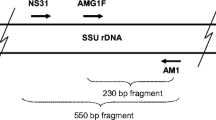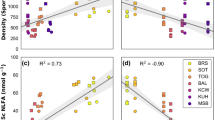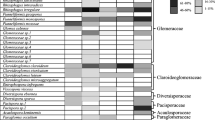Abstract
A study was conducted to establish whether the wild thyme [Thymus polytrichus A. Kerner ex Borbás ssp. britannicus (Ronn.) Kerguelen (Lamiaceae)] growing in the metal-contaminated soils along the River South Tyne, United Kingdom, is colonised by arbuscular mycorrhizal (AM) fungi, and whether the degree of colonisation increases (perhaps suggesting increasing mycorrhizal dependence) or decreases (indicating possible inhibition of AM growth) with increasing degree of soil contamination. Seasonal changes in AM colonisation were also assessed. The AM fungal communities colonising T. polytrichus were also investigated, using the polymerase chain reaction with restriction fragment length polymorphism and sequencing of fungal DNA to establish whether AM species richness varied between sites, and whether fungal ecotypes specific to sites with different amounts of metal contamination could be identified. All plants examined were heavily colonised by AM fungi, and mean percentage root length colonised did not increase significantly with increasing soil metal contamination. However, AM vesicle abundance (percentage of mycorrhizal root length containing vesicles) at the most contaminated site was significantly greater than at the other sites. No significant seasonal variation in degree of colonisation or vesicle abundance was found. Glomus was the predominant AM genus detected at all sites. The number of AM genotypes colonising T. polytrichus roots was similar at all sites but, although some were common to all sites, certain strains appeared to be specific to either the most- or the least-contaminated site. This variation in species may account for the difference in vesicle abundance between sites. The consistently heavy AM colonisation of T. polytrichus found suggests that these fungi are not inhibited by soil heavy metals at these sites, and that the host derives some benefit from its AM symbiont.




Similar content being viewed by others
References
Antoniolli ZI, Schachtman DP, Ophel-Keller K, Smith SE (2000) Variation in rDNA ITS sequences in Glomus mosseae and Gigaspora margarita spores from a permanent pasture. Mycol Res 104:708–715
Clapp JP, Young JPW, Merryweather JW, Fitter AH (1995) Diversity of fungal symbionts in arbuscular mycorrhizas from a natural community. New Phytol 130:259–265
Clapp JP, Rodriguez A, Dodd JC (2001) Inter- and intra-isolate rRNA large subunit variation in Glomus coronatum spores. New Phytol 149:539–554
Daniell TJ, Husband R, Fitter AH, Young JPW (2001) Molecular diversity of arbuscular mycorrhizal fungi colonising arable crops. FEMS Microbiol Ecol 36:203–209
Dehn B, Schüepp H (1989) Influence of VA mycorrhizae on the uptake and distribution of heavy metals in plants. Agric Ecosyst Environ 29:79–83
Douds DD Jr, Pfeffer PE, Shachar-Hill Y (2000) Carbon partitioning, cost, and metabolism of arbuscular mycorrhizas. In: Kapulnik Y, Douds DD Jr (eds) Arbuscular mycorrhizas: physiology and function. Kluwer, Dordrecht, pp 107–129
Filatov D (2001) 2001 processor of sequences manual. University of Birmingham, http://www.biosciences.bham.ac.uk/labs/filatov/proseq.html
Gerdemann JW (1965) Vesicular-arbuscular mycorrhizae formed on maize and tuliptree by Endogone fasciculata. Mycologia 57:562–575
Gerdemann JW (1968) Vesicular-arbuscular mycorrhiza and plant growth. Annu Rev Phytopathol 6:397–418
Gerdemann JW, Trappe JM (1974) The Endogonaceae in the Pacific Northwest. Mycologia: Memoir no. 5
Gildon A, Tinker PB (1983) Interactions of vesicular-arbuscular mycorrhizal infection and heavy metals in plants. I. The effects of heavy metals on the development of vesicular-arbuscular mycorrhizas. New Phytol 95:247–261
Grime JP, Hodgson JG, Hunt R (1988) Comparative plant ecology: a functional approach to common British species. Unwin Hyman, London
Helgason T, Daniell TJ, Husband R, Fitter AH (1998) Ploughing up the wood-wide web? Nature 394:431
Helgason T, Fitter AH, Young JPW (1999) Molecular diversity of arbuscular mycorrhizal fungi colonising Hyacinthoides non-scripta (bluebell) in a seminatural woodland. Mol Ecol 8:659–666
Hepper CM, Smith GA (1976) Observation’s [sic] on the germination of Endogone spores. Trans Br Mycol Soc 66:189–194
Hetrick BAD, Wilson GWT, Figge DAH (1994) The influence of mycorrhizal symbiosis and fertilizer amendments on establishment of vegetation in heavy metal mine spoil. Environ Pollut 86:171–179
Hildebrandt U, Kaldorf M, Bothe H (1999) The zinc violet and its colonization by arbuscular mycorrhizal fungi. J Plant Physiol 154:709–717
Ietswaart JH, Griffioen WAJ, Ernst WHO (1992) Seasonality of VAM infection in three populations of Agrostis capillaris (Gramineae) on soil with or without heavy metal enrichment. Plant Soil 139:67–73
Kaldorf M, Kuhn AJ, Schroder WH, Hildebrandt U, Bothe H (1999) Selective element deposits in maize colonized by a heavy metal tolerance conferring arbuscular mycorrhizal fungus. J Plant Physiol 154:718–728
Khan AG, Kuek C, Chaudhry TM, Khoo CS, Hayes WJ (2000) Role of plants, mycorrhizae and phytochelators in heavy metal contaminated land remediation. Chemosphere 41:197–207
Leyval C, Turnau K, Haselwandter K (1997) Effect of heavy metal pollution on mycorrhizal colonization and function: physiological, ecological and applied aspects. Mycorrhiza 7:139–153
Liao JP, Lin XG, Cao ZH, Shi YQ, Wong MH (2003) Interactions between arbuscular mycorrhizae and heavy metals under sand culture experiment. Chemosphere 50:847–853
Macklin MG, Smith RS (1990) Historic riparian vegetation development and alluvial metallophyte plant communities in the Tyne basin, north-east England. In: Thornes JB (ed) Vegetation and erosion: processes and environment. Wiley, Chichester, UK, pp 239–256
McGonigle TP, Miller MH, Evans DG, Fairchild GL, Swan JA (1990) A method which gives an objective measure of colonization of roots by vesicular-arbuscular mycorrhizal fungi. New Phytol 115:495–501
Morton JB, Redecker D (2001) Two new families of Glomales, Archaeosporaceae and Paraglomaceae, with two new genera Archaeospora and Paraglomus, based on concordant molecular and morphological characters. Mycologia 93:181–195
Mosse (1973) Advances in the study of vesicular-arbuscular mycorrhiza. Annu Rev Phytopathol 11:171–196
Page RDM (1996) An application to display phylogenetic trees on personal computers. Comput Appl Biosci 12:357–358
Raistrick A, Jennings B (1965) A history of lead mining in the Pennines. Longman, London
Rodriguez A, Dougall T, Dodd JC, Clapp JP (2001) The large subunit ribosomal RNA genes of Entrophospora infrequens comprise sequences related to two different glomalean families. New Phytol 152:159–167
Saitou N, Nei M (1987) The neighbor-joining method: a new method for reconstructing phylogenetic trees. Mol Biol Evol 4:406–425
Sanders IR, Fitter AH (1992a) The ecology and functioning of vesicular-arbuscular mycorrhizas in coexisting grassland species. II. Nutrient uptake and growth of vesicular-arbuscular mycorrhizal plants in a semi-natural grassland. New Phytol 120:525–533
Sanders IR, Fitter AH (1992b) The ecology and functioning of vesicular-arbuscular mycorrhizas in coexisting grassland species. I. Seasonal patterns of mycorrhizal occurrence and morphology. New Phytol 120:517–524
Shetty KG, Hetrick BAD, Schwab AP (1995) Effects of mycorrhizae and fertilizer amendments on zinc tolerance of plants. Environ Pollut 88:307–314
Simon L, Lalonde M, Bruns TD (1992) Specific amplification of 18S fungal ribosomal genes from vesicular-arbuscular endomycorrhizal fungi colonizing roots. Appl Environ Microbiol 58:291–295
Thompson JD, Gibson TJ, Plewniak F, Jeanmougin F, Higgins DG (1997) The ClustalX windows interface: flexible strategies for multiple sequence alignment aided by quality analysis tools. Nucleic Acids Res 25:4876–4882
Turnau K (1998) Heavy metal content and localization in mycorrhizal Euphorbia cyparissias from zinc wastes in southern Poland. Acta Soc Bot Pol 67:105–113
Turnau K, Miszalski Z, Trouvelot A, Bonfante P, Gianinazzi S (1996) Oxalis acetosella as a monitoring plant on highly polluted soils. In: Azcón-Aguilar C, Barea JM (eds) Mycorrhizas in integrated systems from genes to plant development. European Commission, Brussels, pp 483–486
Turnau K, Ryszka P, Gianinazzi-Pearson V, van Tuinen D (2001) Identification of arbuscular mycorrhizal fungi in soils and roots of plants colonizing zinc wastes in southern Poland. Mycorrhiza 10:169–174
Val C del, Barea JM, Azcón-Aguilar C (1999) Assessing the tolerance to heavy metals of arbuscular mycorrhizal fungi isolated from sewage sludge-contaminated soils. Appl Soil Ecol 11:261–269
Vandenkoornhuyse P, Husband R, Daniell TJ, Watson IJ, Duck JM, Fitter AH, Young JPW (2002) Arbuscular mycorrhizal community composition associated with two plant species in a grassland ecosystem. Mol Ecol 11:1555–1564
Weiersbye IM, Straker CJ, Przybylowicz WJ (1999) Micro-PIXE mapping of elemental distribution in arbuscular mycorrhizal roots of the grass, Cynodon dactylon, from gold and uranium mine tailings. Nucl Instrum Methods B 158:335–343
Whitfield L (2002). Heavy metal tolerance and mycorrhizal colonisation in Thymus polytrichus A. Kerner ex Borbás ssp. britannicus (Ronn.) Kerguelen (Lamiaceae). PhD thesis, University of Newcastle, UK
Whitfield L, Richards AJ, Rimmer DL (2003) Effects of mycorrhizal colonisation on Thymus polytrichus from heavy-metal-contaminated sites in northern England. Mycorrhiza DOI 10.1007/s00572-003-0269-y
Acknowledgements
Many thanks to Dr. Kirsten Wolff and Dr. Marie Hale (University of Newcastle) and Dr. Thorunn Helgason and Dr. Karyn Ridgway (University of York) for help with and advice on molecular techniques. Thanks also to Philip Green, Jackie Hodgson, Alan White, and the staff at Moor Bank Gardens and Close House Research Station for their valuable technical advice and support.
Author information
Authors and Affiliations
Corresponding author
Rights and permissions
About this article
Cite this article
Whitfield, L., Richards, A.J. & Rimmer, D.L. Relationships between soil heavy metal concentration and mycorrhizal colonisation in Thymus polytrichus in northern England. Mycorrhiza 14, 55–62 (2004). https://doi.org/10.1007/s00572-003-0268-z
Received:
Accepted:
Published:
Issue Date:
DOI: https://doi.org/10.1007/s00572-003-0268-z




